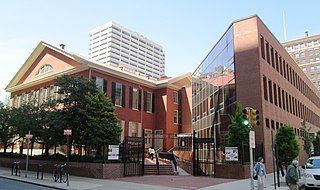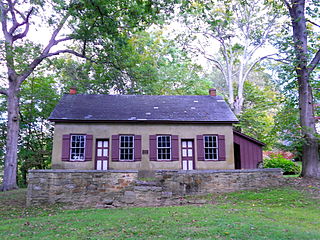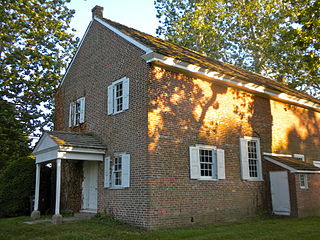
Lincoln is a historic unincorporated village in the Loudoun Valley of Loudoun County, Virginia, located approximately 1.5 miles (2.4 km) south of Purcellville. It was established as the community of "Goose Creek" during the 1750s by Quaker settlers and renamed "Lincoln" after the president shortly after his election.

This is a list of properties and districts in Illinois that are on the National Register of Historic Places. There are over 1,900 in total. Of these, 85 are National Historic Landmarks. There are listings in all of the state's 102 counties.

The Race Street Meetinghouse is an historic and still active Quaker meetinghouse at 1515 Cherry Street at the corner of N. 15th Street in the Center City area of Philadelphia, Pennsylvania. The meetinghouse served as the site of the Yearly Meeting of the Hicksite sect of the Religious Society of Friends (Quakers) from 1857 to 1955.

The Buckingham Friends Meeting House is a historic Quaker meeting house at 5684 Lower York Road in Buckingham Township, Bucks County, Pennsylvania. Built in 1768 in a "doubled" style, it is nationally significant as a model for many subsequent Friends Meeting Houses. It was declared a National Historic Landmark in 2003.

The Merion Friends Meeting House is an active and historic Quaker meeting house at 615 Montgomery Avenue in Merion Station, Pennsylvania. Completed about 1715, it is the second oldest Friends meeting house in the United States, with distinctively Welsh architectural features that distinguish it from later meeting houses. It is home to the Merion monthly meeting. The meeting house was declared a National Historic Landmark in 1999.

Great Friends Meeting House is a meeting house of the Religious Society of Friends (Quakers) built in 1699 in Newport, Rhode Island. The meeting house, which is part of the Newport Historic District, is currently open as a museum owned by the Newport Historical Society. It is the oldest surviving house of worship in Rhode Island and features wide-plank floors, plain benches, a balcony, a beam ceiling, and a shingle exterior. Significant additions were made in 1730, 1807, 1857, and 1867. The meeting house was built on land owned by Nicholas Easton who donated his land in the 1670s and likely his house for the first Quaker meeting house which was located nearby on Farewell Street before the current meeting house was built in 1699.

The Colora Meetinghouse is a historic Friends meeting house located at Colora, Cecil County, Maryland, United States.

Little Egg Harbor Friends Meeting House is a historic Quaker meetinghouse at 21 E. Main Street in Tuckerton, Ocean County, New Jersey, United States. The meetinghouse was built in 1863 and added to the National Register of Historic Places in 2002. Little Egg Harbor Meeting is part of Burlington Quarterly Meeting which is part of the Philadelphia Yearly Meeting. Friends continue to meet at Little Egg Harbor Meeting on Sundays at 10:30 a.m.

Alloways Creek Friends Meetinghouse is a historic Quaker meeting house on Buttonwood Avenue, 150 feet west of Main Street in Hancock's Bridge, Lower Alloways Creek Township, Salem County, New Jersey, United States.

Appoquinimink Friends Meetinghouse, also known as the Odessa Friends Meetinghouse, is a very small but historic Quaker meetinghouse on Main Street in Odessa, Delaware. It was built in 1785 by David Wilson and added to the National Register of Historic Places in 1972. Members of the meeting, including John Hunn and his cousin John Alston, were active in the Underground Railroad and Harriet Tubman may have hid in the meetinghouse. Measuring about 20 feet (6.1 m) by 22 feet (6.7 m), it may be the smallest brick house of worship in the United States.

Friends Meetinghouse is a historic Quaker meeting house at 4th and West Streets in Wilmington, Delaware in the Quaker Hill neighborhood. The meeting is still active with a membership of about 400 and is part of the Philadelphia Yearly Meeting. It was built in 1815–1817 and added to the National Register of Historic Places in 1976.

Spring Friends Meeting House is a historic Quaker meeting house located at Snow Camp, Alamance County, North Carolina. The fourth and current meeting house was built in 1907, and is a small rectangular frame one-story gable-front building. It features Gothic Revival style lancet windows and a short, plain rectangular cupola with pyramidal roof. Spring Friends Meeting is an active congregation of Quakers from the Alamance, Chatham, Orange, Guilford and Randolph County area of North Carolina. Members of the Religious Society of Friends first started "meeting at the spring" around 1761, with the congregation formally recognized by North Carolina Yearly Meeting in 1773. The adjacent contributing cemetery dates from the founding of the meeting, about 1761. It contains the graves of some of the earliest Quaker settlers in Alamance County, as well as the unmarked graves of approximately 25 American Revolutionary War soldiers killed in the 1781 Battle of Lindley's Mill. The battle itself was waged around the meeting house, with governor Thomas Burke and other officials held prisoner in the original meeting house during the battle.

Rancocas is an unincorporated community located within Westampton Township in Burlington County, New Jersey. The name derives from the Native American word Rankokous. which was used in the name of the Powhatan Renape Nation Indian Reservation located in Westampton Township. The name was also known as a sub-tribe of the Ancocus. The Reservation was a popular tourist destination for visitors from the Philadelphia area, New York, and local residents, before the Reservation became Rancocas State Park.

The Goose Creek Meeting House Complex is a Quaker worship center, with an original 1765 Meeting House, an 1817 meeting house, a burying ground, and the Oakdale schoolhouse in the village of Lincoln, Virginia. The complex is on the site of the original log meeting house, built about 1750. The 1765 meeting house is a one-story stone building, and was converted to a residence after the construction of the 1817 meeting house.

Hopewell Friends Meeting House is an 18th-century Quaker meeting house located the northern Frederick County, Virginia one mile west of the community of Clear Brook at 604 Hopewell Road. Clear Brook, VA 22624. This community was the home of Thomas William "Tom" Fox (1951–2006), a Quaker peace activist, affiliated with Christian Peacemaker Teams (CPT) murdered in 2006 in Iraq.

Iowa Yearly Meeting House-College Avenue Friends Church is a historic church building located in Oskaloosa, Iowa, United States. The Colonial Revival structure was designed by Bloomington, Illinois architect A.T. Simmons, and completed in 1913. As their membership declined, Quakers in Iowa decided to concentrate on a few fundamental tenets of their faith, but gave way on their traditional concerns about simplicity and restraint. This more elaborate building replaced a simple 2½-story, brick and stone structure that was completed in 1865. The building project was a cooperative arraignment that included the Yearly Meeting, the Monthly Meeting, and nearby William Penn College. Oskaloosa had been chosen as the location of the Iowa Yearly Meeting, or the denominational headquarters, because of its central location to where the Quakers settled west of the Mississippi River. The previous building had separate meeting facilities for men and women, and this one does not. That separation was no longer considered necessary by the time this building was built. It was listed on the National Register of Historic Places in 1996.

Whittier Friends Meeting House is a historic church building at the junction of County Roads E34 and X20 in Whittier, Iowa. It was built in 1893.

The Spring Creek Friends Cemetery is a historic site located northeast of Oskaloosa, Iowa, United States. The approximately one-half acre plot of land contains an unknown number of burials with about 123 having plain markers that date from the 1860s through the 1890s. There is a network of pedestrian paths in the cemetery, and it is surrounded by a fence with concrete posts on the south, west, and north sides. The cemetery was founded about 1848 and continued to accept burials until about 1892. It calls attention to the earliest period of Quaker settlement in Iowa, which at that time was primarily a rural phenomenon. The Spring Creek Meeting was established here in the 1840s or the 1850s, and was the site of the first Iowa Yearly Meeting in 1863. The Spring Creek Meeting merged with the Center Grove Meeting in 1894 and formed the Oskaloosa Monthly Meeting. The meetinghouse subsequently moved into Oskaloosa, and burials here dropped off. The cemetery was listed on the National Register of Historic Places in 1996.

The Spring Creek Meeting House-H Street Mission was an historic building in Oskaloosa, Iowa, United States. The frame building was built sometime after an 1878 fire destroyed the original meeting house. It was relocated from its original rural location to this site in 1895. The Spring Creek Meeting was organized in 1844 outside of town. It calls attention to the movement of the Quakers from a rural setting to a central location in town. After its relocation it became a mission of the Oskaloosa Monthly Meeting. This illustrates the evangelical nature of the Iowa Yearly Meeting after the Schism of 1877, and their willingness to proselytize in order to rectify the decline in membership on the frontier. Such a move was an anomaly among Eastern Quakers. The architecture itself shows a shift in Quaker meeting houses in Iowa from structures that were long and low to this one with its high-pitched gable roof. It was listed on the National Register of Historic Places in 1996. The building has subsequently been torn down.

The Oskaloosa Monthly Meeting of Friends Parsonage is a historic building located in Oskaloosa, Iowa, United States. Its historic significance is found in its association with nearby William Penn University in the context of the Quaker testimony in Oskaloosa. The country's entry into World War I created problems for the Quaker's Peace Testimony. The Oskaloosa Monthly Meeting counseled students from the college about military conscription and pacifism. Because of this the parsonage was vandalized in 1917 with yellow crosses painted on the house. The congregation's pastor, Clarence Pickett, was tied to a spring wagon and led through town. Some vandalism also occurred during World War II, including yellow paint smeared on the parsonage.





















